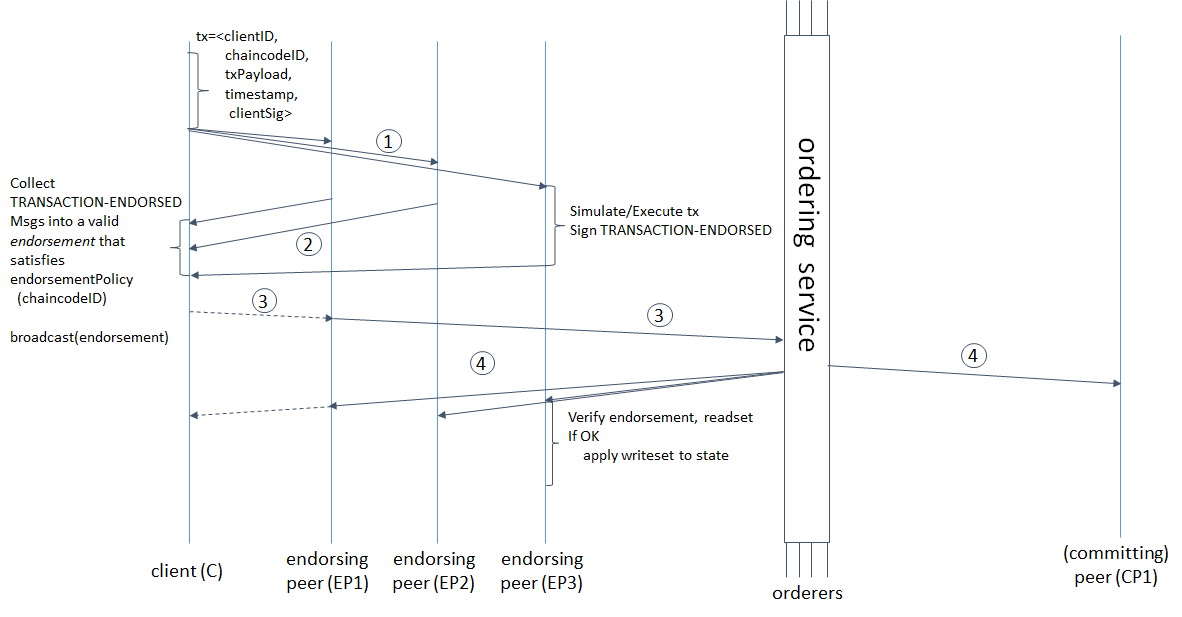Transaction Flow¶
This document outlines the transactional mechanics that take place during a standard asset exchange. The scenario includes two clients, A and B, who are buying and selling radishes. They each have a peer on the network through which they send their transactions and interact with the ledger.

Assumptions
This flow assumes that a channel is set up and running. The application user has registered and enrolled with the organization’s Certificate Authority (CA) and received back necessary cryptographic material, which is used to authenticate to the network.
The chaincode (containing a set of key value pairs representing the initial
state of the radish market) is installed on the peers and deployed to the
channel. The chaincode contains logic defining a set of transaction instructions
and the agreed upon price for a radish. An endorsement policy has also been set
for this chaincode, stating that both peerA and peerB must endorse any
transaction.

- Client A initiates a transaction
What’s happening? Client A is sending a request to purchase radishes. This
request targets peerA and peerB, who are respectively representative of
Client A and Client B. The endorsement policy states that both peers must
endorse any transaction, therefore the request goes to peerA and peerB.
Next, the transaction proposal is constructed. An application leveraging a supported SDK (Node, Java, Python) utilizes one of the available API’s to generate a transaction proposal. The proposal is a request to invoke a chaincode function with certain input parameters, with the intent of reading and/or updating the ledger.
The SDK serves as a shim to package the transaction proposal into the properly architected format (protocol buffer over gRPC) and takes the user’s cryptographic credentials to produce a unique signature for this transaction proposal.

- Endorsing peers verify signature & execute the transaction
The endorsing peers verify (1) that the transaction proposal is well formed, (2) it has not been submitted already in the past (replay-attack protection), (3) the signature is valid (using the MSP), and (4) that the submitter (Client A, in the example) is properly authorized to perform the proposed operation on that channel (namely, each endorsing peer ensures that the submitter satisfies the channel’s Writers policy). The endorsing peers take the transaction proposal inputs as arguments to the invoked chaincode’s function. The chaincode is then executed against the current state database to produce transaction results including a response value, read set, and write set (i.e. key/value pairs representing an asset to create or update). No updates are made to the ledger at this point. The set of these values, along with the endorsing peer’s signature is passed back as a “proposal response” to the SDK which parses the payload for the application to consume.
Note
The MSP is a peer component that allows peers to verify transaction requests arriving from clients and to sign transaction results (endorsements). The writing policy is defined at channel creation time and determines which users are entitled to submit a transaction to that channel. For more information about membership, check out our Membership Service Provider (MSP) documentation.

- Proposal responses are inspected
The application verifies the endorsing peer signatures and compares the proposal responses to determine if the proposal responses are the same. If the chaincode is only querying the ledger, the application would only inspect the query response and would typically not submit the transaction to the ordering service. If the client application intends to submit the transaction to the ordering service to update the ledger, the application determines if the specified endorsement policy has been fulfilled before submitting (i.e. did peerA and peerB both endorse). The architecture is such that even if an application chooses not to inspect responses or otherwise forwards an unendorsed transaction, the endorsement policy will still be enforced by peers and upheld at the commit validation phase.

- Client assembles endorsements into a transaction
The application “broadcasts” the transaction proposal and response within a “transaction message” to the ordering service. The transaction will contain the read/write sets, the endorsing peers signatures and the Channel ID. The ordering service does not need to inspect the entire content of a transaction in order to perform its operation, it simply receives transactions from all channels in the network, orders them chronologically by channel, and creates blocks of transactions per channel.

- Transaction is validated and committed
The blocks of transactions are “delivered” to all peers on the channel. The transactions within the block are validated to ensure endorsement policy is fulfilled and to ensure that there have been no changes to ledger state for read set variables since the read set was generated by the transaction execution. Transactions in the block are tagged as being valid or invalid.

- Ledger updated
Each peer appends the block to the channel’s chain, and for each valid transaction the write sets are committed to current state database. An event is emitted by each peer to notify the client application that the transaction (invocation) has been immutably appended to the chain, as well as notification of whether the transaction was validated or invalidated.
Note
Applications should listen for the transaction event after submitting
a transaction, for example by using the submitTransaction
API, which automatically listen for transaction events. Without
listening for transaction events, you will not know
whether your transaction has actually been ordered, validated, and
committed to the ledger.
You can also use the swimlane sequence diagram below to examine the transaction flow in more detail.
